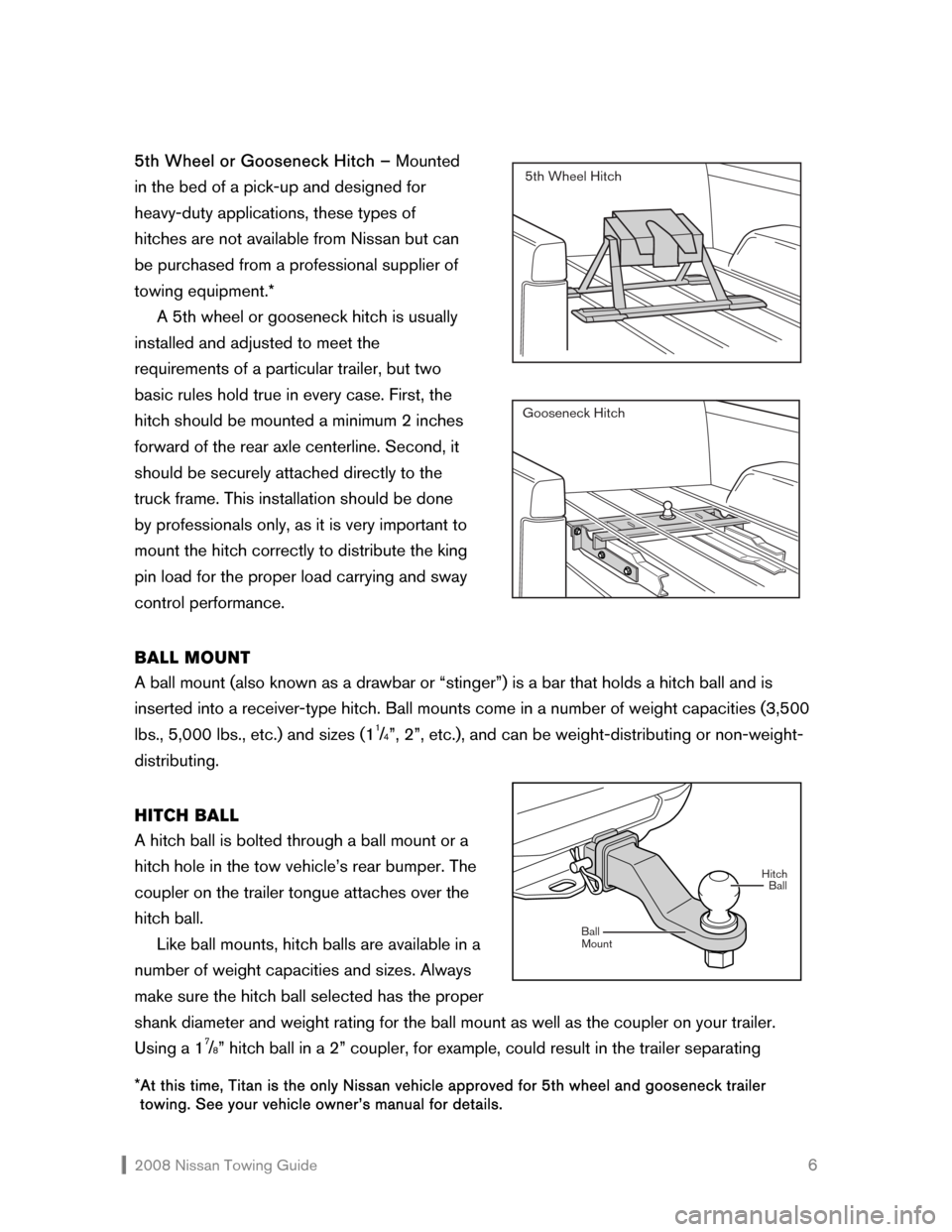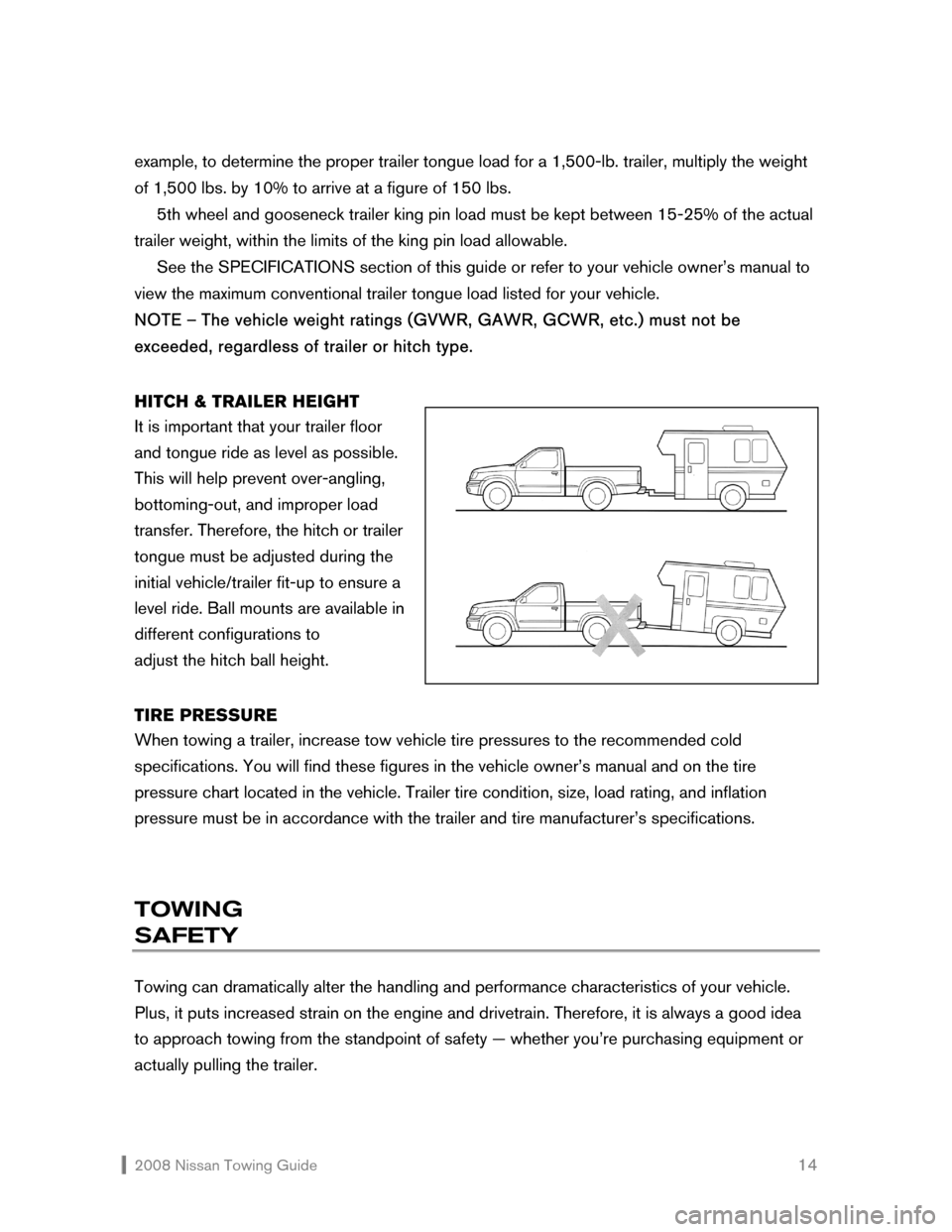2008 NISSAN QUEST wheel size
[x] Cancel search: wheel sizePage 7 of 32

2008 Nissan Towing Guide 6 5th Wheel or Gooseneck Hitch – Mounted
in the bed of a pick-up and designed for
heavy-duty applications, these types of
hitches are not available from Nissan but can
be purchased from a professional supplier of
towing equipment.*
A 5th wheel or gooseneck hitch is usually
installed and adjusted to meet the
requirements of a particular trailer, but two
basic rules hold true in every case. First, the
hitch should be mounted a minimum 2 inches
forward of the rear axle centerline. Second, it
should be securely attached directly to the
truck frame. This installation should be done
by professionals only, as it is very important to
mount the hitch correctly to distribute the king
pin load for the proper load carrying and sway
control performance.
BALL MOUNT
A ball mount (also known as a drawbar or “stinger”) is a bar that holds a hitch ball and is
inserted into a receiver-type hitch. Ball mounts come in a number of weight capacities (3,500
lbs., 5,000 lbs., etc.) and sizes (1
1/4”, 2”, etc.), and can be weight-distributing or non-weight-
distributing.
HITCH BALL
A hitch ball is bolted through a ball mount or a
hitch hole in the tow vehicle’s rear bumper. The
coupler on the trailer tongue attaches over the
hitch ball.
Like ball mounts, hitch balls are available in a
number of weight capacities and sizes. Always
make sure the hitch ball selected has the proper
shank diameter and weight rating for the ball mount as well as the coupler on your trailer.
Using a 1
7/8” hitch ball in a 2” coupler, for example, could result in the trailer separating
*At this time, Titan is the only Nissan vehicle approved for 5th wheel and gooseneck trailer
towing. See your vehicle owner’s manual for details.
5th Wheel Hitch
Gooseneck Hitch
Hitch
Mount BallBall
Page 15 of 32

2008 Nissan Towing Guide 14 example, to determine the proper trailer tongue load for a 1,500-lb. trailer, multiply the weight
of 1,500 lbs. by 10% to arrive at a figure of 150 lbs.
5th wheel and gooseneck trailer king pin load must be kept between 15-25% of the actual
trailer weight, within the limits of the king pin load allowable.
See the SPECIFICATIONS section of this guide or refer to your vehicle owner’s manual to
view the maximum conventional trailer tongue load listed for your vehicle.
NOTE – The vehicle weight ratings (GVWR, GAWR, GCWR, etc.) must not be
exceeded, regardless of trailer or hitch type.
HITCH & TRAILER HEIGHT
It is important that your trailer floor
and tongue ride as level as possible.
This will help prevent over-angling,
bottoming-out, and improper load
transfer. Therefore, the hitch or trailer
tongue must be adjusted during the
initial vehicle/trailer fit-up to ensure a
level ride. Ball mounts are available in
different configurations to
adjust the hitch ball height.
TIRE PRESSURE
When towing a trailer, increase tow vehicle tire pressures to the recommended cold
specifications. You will find these figures in the vehicle owner’s manual and on the tire
pressure chart located in the vehicle. Trailer tire condition, size, load rating, and inflation
pressure must be in accordance with the trailer and tire manufacturer’s specifications.
TOWING
SAFETY
Towing can dramatically alter the handling and performance characteristics of your vehicle.
Plus, it puts increased strain on the engine and drivetrain. Therefore, it is always a good idea
to approach towing from the standpoint of safety — whether you’re purchasing equipment or
actually pulling the trailer.
Page 23 of 32

2008 Nissan Towing Guide 22
GOOSENECK HITCH Located just forward of the rear axle centerline, this hitch uses a
ball to serve as the pivot point for the trailer.
GROSS AXLE
WEIGHT RATING (GAWR)
The maximum amount of weight each vehicle axle (front and rear) is
designed to safely carry.
GROSS COMBINED
WEIGHT RATING (GCWR) The maximum allowable combined weight of the vehicle and trailer,
including passengers and all cargo.
GROSS VEHICLE
WEIGHT RATING (GVWR) The maximum allowable weight of the vehicle, including
passengers, cargo, fuel, hitch, trailer tongue load, and any optional
equipment.
KING PIN
LOAD The amount of trailer (5th wheel or gooseneck) weight pressing
down on the tow vehicle hitch.
HITCH BALL
A ball that connects the trailer to the tow vehicle hitch and provides
the means by which the trailer pivots during cornering. Available in
a number of sizes and weight capacities, it must correspond to the
trailer coupler size, and have a sufficient capacity rating for the
trailer being pulled.
RECEIVER HITCH A frame- or structure-mounted hitch with a receiver that allows
removal of the ball mount.
SAFETY CHAINS/CABLES Provides an emergency connection between the tow vehicle and
the trailer, should the trailer become disengaged for any reason.
SURGE BRAKES
Hydraulic-type braking system activated by inertia. As the tow
vehicle begins to brake, the trailer pushes against the hitch ball,
consequently activating the trailer brakes.
TRAILER TONGUE/COUPLER The part of the trailer that extends forward to meet the tow vehicle,
and also carries the coupler assembly.
TRAILER TONGUE
LOAD The amount of trailer (conventional) weight pressing down on the
tow vehicle hitch.
WEIGHT-DISTRIBUTING
HITCH SYSTEM Type of hitch system that helps shift the trailer tongue weight to all
trailer tires and the tow vehicle front tires. Strongly recommended
when towing trailers with a Maximum Trailer Weight greater than
5,000 lbs.
WIRING HARNESS
Provides an electrical connection linking the tow vehicle’s electrical
system to the trailer’s system.
Page 28 of 32

2008 Nissan Towing Guide 27
Passenger Vehicles – The towing capacity for 350Z Coupe, Altima (Coupe, Hybrid, and
Sedan), Maxima, and Sentra is 1,000 lbs.; the maximum trailer tongue load is 100 lbs.
DO NOT
tow a trailer with 350Z Roadster or Versa.
NOTE – For passenger vehicles, the trailer tongue load must be subtracted from the GVWR
as shown on the F.M.V.S.S. certification label located in the driver’s-side door area.
2008 XTERRA TOWING DATA
Engine Type 4.0L V6
Transmission A/T & M/T
Model(s) 2WD & 4WD
Maximum
Trailer Weight1 (lbs.) 5,000
Maximum
Trailer Tongue Load (lbs.) 500
Gross Combined
Weight Rating (lbs.) 9,658
Maximum Trailer
Frontal Area 60 sq. ft.
1 Maximum Trailer Weight values are calculated assuming a base vehicle with driver and any options
required to achieve the rating. Additional passengers, cargo and/or optional equipment will add weight
to the vehicle and reduce your vehicle’s maximum towing capacity and trailer tongue load.
2 The Maximum Trailer Weight when using the Genuine Nissan step bumper in this application as a ball
mount is 5,000 lbs.; the Maximum Trailer Tongue Load is 500 lbs.
3 The Maximum Trailer Weight when using the Genuine Nissan step bumper in this application as a ball
mount is 3,500 lbs.; the Maximum Trailer Tongue Load is 350 lbs. 4 Requires weight-distributing hitch system when towing over 5,000 lbs. 5 The Maximum Trailer Weight and Gross Combined Weight ratings for 5th wheel and gooseneck trailer
towing are the same as specified for conventional trailer towing.
6 The vehicle optional tow package does not include a ball mount. Two ball mount options are available
through your Nissan dealer:
�Š Class III hitch ball mount for trailers with a Maximum Trailer Weight of 5,000 lbs. or less.
NOTE – A hitch ball is not included with the Class III ball mount. This ball mount can be used with
any hitch ball with a shank diameter of 1” or larger.
�Š Class IV weight-distributing hitch ball mount for trailers with a Maximum Trailer Weight greater
than 5,000 lbs. This ball mount can also be used with trailers under 5,000 lbs. Maximum Trailer
Weight.
NOTE – The Class IV ball mount includes a 2
5/16” hitch ball rated for 10,000 lbs. Smaller hitch
ball sizes may be used by following the instructions included in the ball mount kit.
NOTES:
�Š Most states require a separate braking system on trailers with a loaded weight above a specific
smount. Check local ordinances.
�Š A/T – Automatic Transmission, CVT – Continuously Variable Transmission